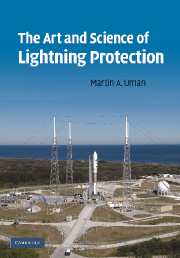Book contents
- Frontmatter
- Contents
- Preface
- 1 What is lightning?
- 2 Lightning damage
- 3 General methods for lightning protection: Faraday cages, topological shields; and more practical approaches: cone of protection and rolling sphere methods
- 4 Structure protection: air terminals and down conductors
- 5 Structure protection: grounding
- 6 Surge protection for electronics in low-voltage electrical systems
- 7 Humans and animals
- 8 Lightning warning
- 9 Airships, airplanes, and launch vehicles
- 10 Ships and boats
- 11 Trees
- 12 Overhead and underground power and communication lines
- 13 Lightning elimination
- 14 So, what do we know and what don't we know about lightning protection?
- Index
- References
2 - Lightning damage
Published online by Cambridge University Press: 17 November 2009
- Frontmatter
- Contents
- Preface
- 1 What is lightning?
- 2 Lightning damage
- 3 General methods for lightning protection: Faraday cages, topological shields; and more practical approaches: cone of protection and rolling sphere methods
- 4 Structure protection: air terminals and down conductors
- 5 Structure protection: grounding
- 6 Surge protection for electronics in low-voltage electrical systems
- 7 Humans and animals
- 8 Lightning warning
- 9 Airships, airplanes, and launch vehicles
- 10 Ships and boats
- 11 Trees
- 12 Overhead and underground power and communication lines
- 13 Lightning elimination
- 14 So, what do we know and what don't we know about lightning protection?
- Index
- References
Summary
Overview: the cost of various types of lightning damage
In the early evening of July 13, 1977, lightning struck one or more 345 000 volt (345 kV) transmission lines located about 30 miles north of New York City. Those transmission lines supplied electrical power to the New York City metropolitan area. A chain reaction of electrical events ensued with the result that electricity was lost to all of the City by 9:34 p.m. It was the next night, the night of July 14, before all electrical power was restored. About 9 million people spent a night and a day without any electricity. By the time that the blackout ended, nearly 2000 stores and businesses had been looted or damaged, and more than 3500 people had been arrested. The cost of this lightning-caused blackout has been estimated at $350 million (Sugarman 1978). A detailed technical description of its causes is found in Wilson and Zarakas (1978) and a complete bibliography of publications concerning the blackout (including testimony before Congressional committees, books, and magazine articles) is found at http://chnm.gmu.edu/search_results.php?query=new%20york%20city%20blackout.
In Minnesota on June 25, 1998, two separate lightning flashes struck and caused the de-energization of two separate 345 kV transmission lines, initiating the cascading removal of overloaded lower voltage lines from service. In a short period of time, significant portions of Minnesota, Montana, North Dakota, South Dakota, Wisconsin, Ontario, Manitoba, and Saskatchewan were without electrical power and remained so for about 19 hours.
- Type
- Chapter
- Information
- The Art and Science of Lightning Protection , pp. 25 - 42Publisher: Cambridge University PressPrint publication year: 2008
References
- 5
- Cited by



